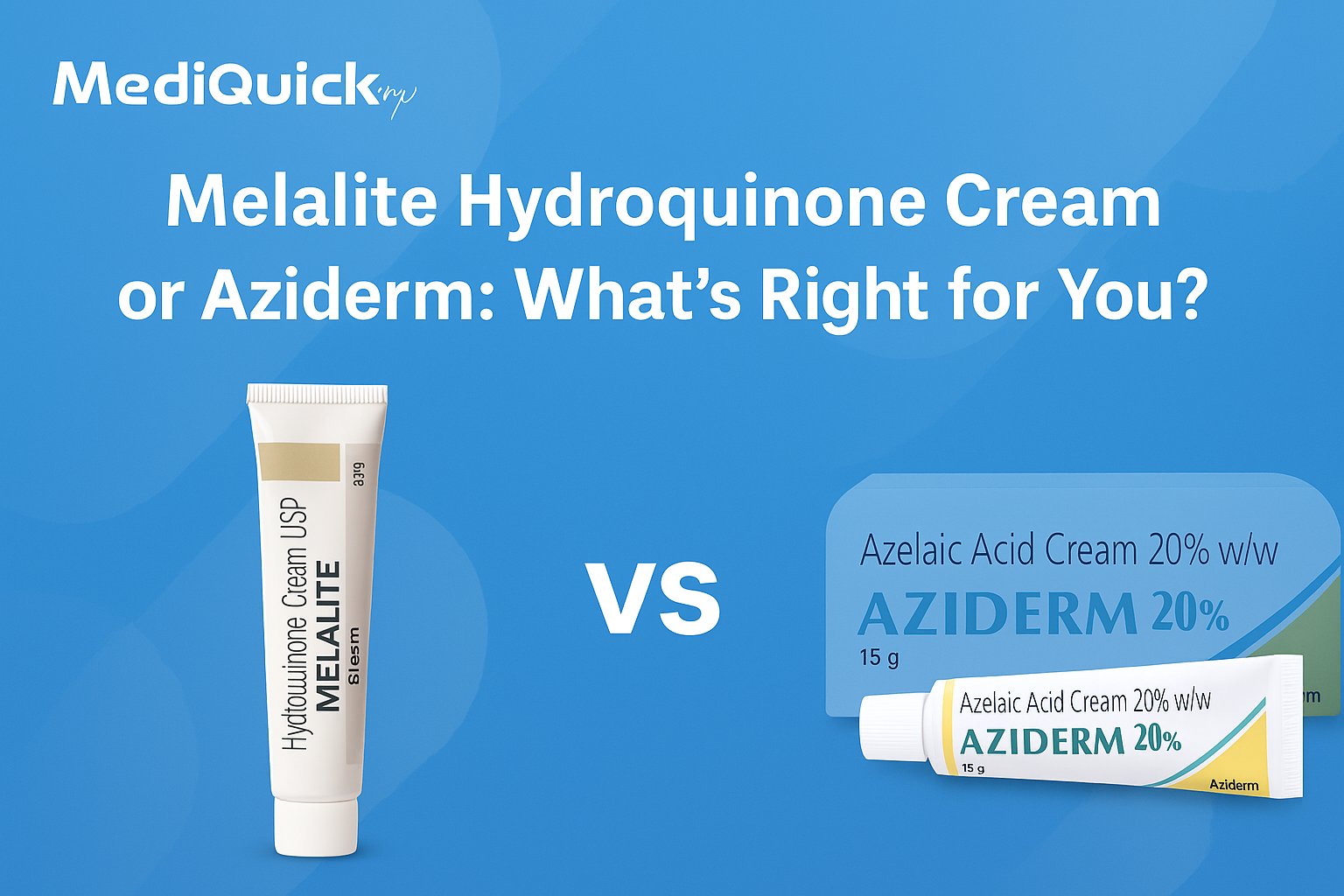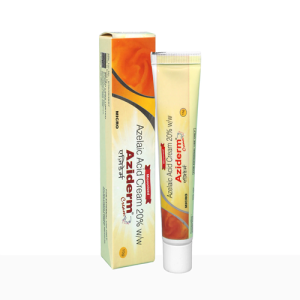When one thinks about how to handle issues with pigmentation and skin discoloration, two names that often come up are Melalite Hydroquinone Cream and Aziderm (Azelaic Acid). Though both are effective treatments, their objectives and skin types differ significantly. Many factors—your skin type, the kind of your pigmentation, how sensitive your skin is, and whether you’re looking for short-term or long-term treatment—helps one to choose between the two.
This paper looks at both options carefully to help you choose which treatment would be most suitable for your skincare needs.
Understanding the Basics
Melalite Hydroquinone Cream
Typically at doses of 2% or 4%, Melalite is a topical cream containing hydroquinone. A potent skin-lightening agent, hydroquinone works by inhibiting the enzyme tyrosinase, which is essential for melanin production in the skin. By means of melanin production suppression, hydroquinone gradually lowers dark spots, melasma, age spots, and other types of hyperpigmentation.
Dermatologists typically recommend hydroquinone for:
- Melasma
- Sunspots
- Freckles
- Post-inflammatory hyperpigmentation
- Uneven skin color
So, under a dermatologist’s direction, hydroquinone should not often be recommended for long-term use.
Get and stay hard at 98% less cost!
Aziderm (Azelaic Acid)
Typically at 10% or 20% potency, Aziderm is a topical cream or gel made with azelaic acid. A naturally occurring dicarboxylic acid, azelaic acid is found in grains including barley, wheat, and rye. It has antimicrobial, anti-inflammatory, and skin-lightening properties.
Aziderm is often advised for:
- Mild to moderate acne
- Rosacea
- Acne scars and dark patches
- Dark spots and acne scars
Often chosen by people with sensitive or acne-prone skin, azelaic acid is suitable for long-term use unlike hydroquinone.
How Do They Work?
Mechanism of Melalite
Hydroquinone works by directly stopping the production of melanin in the skin. Melanin is the pigment giving your skin its tint. By way of melanin synthesis, hydroquinone eliminates existing dark spots and prevents new ones forming. Conversely, this makes the skin more sensitive to sunlight, therefore using Melalite calls for strong sun protection.
Mechanism of Aziderm
Azelaic acid functions in several ways:
- Though not as powerfully as hydroquinone, it reduces melanin production.
- It eliminates acne-causing germs and helps clear clogged pores.
- Its anti-inflammatory properties assist with rosacea and redness.
- It promotes moderate exfoliation, hence improving skin texture.
These benefits make Aziderm often recommended for those with acne as well as pigmentation.
Benefits and Drawbacks
| Feature | Melalite (Hydroquinone) | Aziderm (Azelaic Acid) |
| Main Use | Hyperpigmentation, Melasma | Acne, Pigmentation, Rosacea |
| Speed of Results | Faster (4–6 weeks) | Slower (8–12 weeks) |
| Suitability | Normal to oily skin | Sensitive, acne-prone skin |
| Long-Term Use | Not recommended (>12 weeks) | Safe for long-term |
| Side Effects | Redness, irritation, rebound pigmentation | Mild stinging, dryness |
| Prescription Needed | Often (for 4%) | Sometimes (for 20%) |
When Should You Choose Melalite?
Melalite could be the appropriate option for you if:
- You have persistent, deep pigmentation that has not reacted to other therapies.
- You’re targeting small, specific areas like sun spots or melasma patches.
- You want faster results.
- Your use of it is being supervised by a dermatologist.
- You are committed to strict sun protection and hydration.
Hydroquinone could cause irritation if your skin is sensitive, you have eczema, or you have aggressive acne. Overuse or misuse could lead to unwanted side effects such exogenous ochronosis, a bluish-black skin pigmentation.
When Should You Choose Aziderm?
Aziderm is often a better fit if:
- You have sensitive skin or rosacea.
- You suffer from acne as well as pigmentation.
- You want a long-term safe solution.
- You want steady, continuous progress over quick outcomes.
- You want a product with multi-functional advantages (acne management, anti-inflammatory, gentle exfoliation).
- Aziderm is moderate yet potent for ongoing maintenance or for those who cannot tolerate more harsh treatments.
Safety and Application Tips
To avoid irritation and maximize the benefits of any product you choose, correct application is vitally essential.
- After washing your skin with a mild cleanser, cleanse it dry.
- Unless otherwise instructed, avoid applying the cream to large regions; instead, use a pea-sized amount on the affected area.
- To keep skin hydration, moisturize later
- Use a broad-spectrum sunscreen. Both hydroquinone and azelaic acid could make your skin more sun-sensitive.
- Unless directed by a doctor, avoid mixing several active components such retinoids or AHAs.
Should you experience redness, irritation, or peeling, cut back on use or stop it and see a dermatologist.
Which One Is Right for You?
Here is a fast overview:
- Choose Melalite if:
You have severe, chronic pigmentation, want faster results, and don’t mind temporary use with possible irritation. - Choose Aziderm if:
You have sensitive or acne-prone skin, want to treat multiple concerns at once, and are looking for a milder, long-term solution.
Final Thoughts
Although Melalite and Aziderm both function, your specific skin needs will decide which one you select. More concentrated and stronger, Melalite is ideal for under medical supervision short-term use. Aziderm is suitable for long-term, daily use since it is mild and flexible.
Starting a new product is always best talked with a dermatologist, as with any skincare therapy. They can assess your medical history, skin type, and condition to recommend the most safe and effective option for you.
Clear, even-toned skin is possible with the right mindset and some time.



